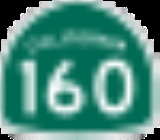
Antioch Bridge
Encyclopedia
The Antioch Bridge crosses the San Joaquin River
linking Antioch, California
with Sacramento County, California
. The bridge is signed as part of State Route 160
. Unlike the other toll bridges in California, the Antioch bridge has only one lane going in each direction. It has bicycle and pedestrian access.
. The original lift span bridge was plagued with problems throughout its lifetime. Heavy traffic could cross it at no more than 15 miles per hour (24.1 km/h), and its narrow shipping canal led to collisions in 1958, 1963 and 1970.
The 1970 collision spurred efforts to build a replacement bridge. In that incident, the lift span was stuck in the raised position. The bridge tender could not leave the bridge and remained in the control house for three days. Local firemen eventually made their way to him and brought him out, and he immediately quit his position. He went on to tend bridges in the Ryde/Walnut Grove area for many years.
The bridge was tolled when it first opened, but tolls were removed after the state bought the bridge in 1940. Tolls were reinstated with the construction of the new span.
users; booths #1 and #2 accept toll payment by both cash and FasTrak.
San Joaquin River
The San Joaquin River is the largest river of Central California in the United States. At over long, the river starts in the high Sierra Nevada, and flows through a rich agricultural region known as the San Joaquin Valley before reaching Suisun Bay, San Francisco Bay, and the Pacific Ocean...
linking Antioch, California
Antioch, California
Antioch is a city in Contra Costa County, California. Located in the East Bay region of the San Francisco Bay Area along the San Joaquin-Sacramento River Delta, it is a suburb of San Francisco and Oakland. The city's population was 102,372 at the U.S...
with Sacramento County, California
Sacramento County, California
Sacramento County is a county in the U.S. state of California. Its county seat is Sacramento, which is also the state capital. As of 2010 the county had a population of 1,418,788....
. The bridge is signed as part of State Route 160
California State Route 160
State Route 160 is a state highway in the U.S. state of California consisting of two sections. The longer, southern, section is a scenic highway through the alluvial plain of the Sacramento River, linking SR 4 in Antioch with Sacramento via the Antioch Bridge...
. Unlike the other toll bridges in California, the Antioch bridge has only one lane going in each direction. It has bicycle and pedestrian access.
History
The current bridge was completed and opened to traffic in 1978. It measures 1.8 miles (2.9 km). It replaced the original structure that was built in 1926 by Aven Hanford and Oscar Klatt, who went on to build the original span of the Carquinez BridgeCarquinez Bridge
The Carquinez Bridge refers to parallel bridges spanning the Carquinez Strait, forming part of Interstate 80 between Crockett and Vallejo, California. The name originally referred to a single cantilever bridge built in 1927, helping to form a direct route between San Francisco and Sacramento. A...
. The original lift span bridge was plagued with problems throughout its lifetime. Heavy traffic could cross it at no more than 15 miles per hour (24.1 km/h), and its narrow shipping canal led to collisions in 1958, 1963 and 1970.
The 1970 collision spurred efforts to build a replacement bridge. In that incident, the lift span was stuck in the raised position. The bridge tender could not leave the bridge and remained in the control house for three days. Local firemen eventually made their way to him and brought him out, and he immediately quit his position. He went on to tend bridges in the Ryde/Walnut Grove area for many years.
The bridge was tolled when it first opened, but tolls were removed after the state bought the bridge in 1940. Tolls were reinstated with the construction of the new span.
Tolls
The Antioch bridge toll plaza is located at the south end of the bridge. Tolls are charged only for northbound traffic. The toll plaza has three toll booths and an administration building located on the right side of the plaza. As with the other toll plazas in the San Francisco Bay Area, the toll booths are numbered starting from the side on which the administration building is located. Currently, booth #3 (i.e. the far left booth) is dedicated to FasTrakFasTrak
FasTrak is the electronic toll collection system used in the state of California in the United States. The system is used statewide on all of the toll roads, toll bridges, and high occupancy/toll and express toll lanes along the California Freeway and Expressway System.As with other ETC systems,...
users; booths #1 and #2 accept toll payment by both cash and FasTrak.

